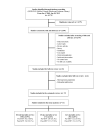The effect of massive transfusion protocol implementation on the survival of trauma patients: a systematic review and meta-analysis
- PMID: 32955420
- PMCID: PMC7605882
- DOI: 10.2450/2020.0065-20
The effect of massive transfusion protocol implementation on the survival of trauma patients: a systematic review and meta-analysis
Abstract
Background: Massive transfusion protocol (MTP) has been widely adopted for the care of bleeding trauma patients but its actual effectiveness is unclear. An earlier meta-analysis on the implementation of MTP for injured patients from 1990 to 2013 reported that only 2 out of 8 studies showed statistical improvement in survival. This study aimed to conduct an updated systematic review and meta-analysis to evaluate the effect of implementing an MTP on the mortality of trauma patients.
Materials and methods: MEDLINE, PubMed, Cochrane Library and Google scholar databases were systematically searched for relevant studies published from 1st January 2008 to 30th September 2019 using a combination of keywords and additional manual searching of reference lists. Inclusion criteria were: original study in English, study population including trauma patients, and comparison of mortality outcomes before and after institutional implementation of an MTP. Primary outcomes were 24-hour, 30-day, and overall mortality.
Results: Fourteen studies met inclusion criteria, analysing outcomes from 3,201 trauma patients. There was a wide range of outcomes, patient populations, and process indicators utilised by the different authors. MTP significantly reduced the overall mortality for trauma patients (OR 0.71 [0.56-0.90]). No significant reduction was seen in either the 24-hour mortality (OR 0.81 [0.57-1.14]) or the 30-day mortality (OR 0.73 [0.46-1.16]). However, when mortality timing was unspecified, mortality was statistically reduced (OR 0.69 [0.55-0.86]).
Discussion: The present study found a significant reduction in mortality following MTP implementation and thus it should be recommended to all institutions managing acutely injured patients. To better identify which elements of an MTP contribute to this effect, we encourage the use of standard nomenclature, indicators, protocols and patient populations in all future MTP studies.
Conflict of interest statement
The Authors declare no conflicts of interest.
Figures



Comment in
-
If not now, when? The value of the MTP in managing massive bleeding.Blood Transfus. 2020 Nov;18(6):415-418. doi: 10.2450/2020.0275-20. Epub 2020 Sep 18. Blood Transfus. 2020. PMID: 32955418 Free PMC article. No abstract available.
Similar articles
-
Massive transfusion protocols in nontrauma patients: A systematic review and meta-analysis.J Trauma Acute Care Surg. 2019 Mar;86(3):493-504. doi: 10.1097/TA.0000000000002101. J Trauma Acute Care Surg. 2019. PMID: 30376535
-
Implementation of a Massive Transfusion Protocol: Evaluation of Its Use and Efficacy.J Trauma Nurs. 2018 Mar/Apr;25(2):92-97. doi: 10.1097/JTN.0000000000000350. J Trauma Nurs. 2018. PMID: 29521775
-
Not only in trauma patients: hospital-wide implementation of a massive transfusion protocol.Transfus Med. 2014 Jun;24(3):162-8. doi: 10.1111/tme.12096. Epub 2013 Dec 26. Transfus Med. 2014. PMID: 24372790 Free PMC article.
-
Effectiveness of massive transfusion protocols on mortality in trauma: a systematic review and meta-analysis.ANZ J Surg. 2013 Dec;83(12):918-23. doi: 10.1111/ans.12417. Epub 2013 Oct 21. ANZ J Surg. 2013. PMID: 24147731
-
Emergency red cells first: Rapid response or speed bump? The evolution of a massive transfusion protocol for trauma in a single UK centre.Injury. 2015 Sep;46(9):1772-8. doi: 10.1016/j.injury.2015.05.046. Epub 2015 May 31. Injury. 2015. PMID: 26068644
Cited by
-
A Selection of Trauma Scores Might Not Correlate with Coagulation Factor Activity following Multiple Injuries: A Retrospective Observational Study from a Level 1 Trauma Center.Biomed Res Int. 2020 Dec 30;2020:6726017. doi: 10.1155/2020/6726017. eCollection 2020. Biomed Res Int. 2020. PMID: 33457412 Free PMC article.
-
If not now, when? The value of the MTP in managing massive bleeding.Blood Transfus. 2020 Nov;18(6):415-418. doi: 10.2450/2020.0275-20. Epub 2020 Sep 18. Blood Transfus. 2020. PMID: 32955418 Free PMC article. No abstract available.
-
Identification of Predictive Factors for Massive Transfusion Activation in Trauma Patients: A Systematic Review and Meta-analysis.J Emerg Trauma Shock. 2024 Oct-Dec;17(4):212-220. doi: 10.4103/jets.jets_19_24. Epub 2024 Aug 28. J Emerg Trauma Shock. 2024. PMID: 39911466 Free PMC article.
-
Transfusion strategies in bleeding critically ill adults: a clinical practice guideline from the European Society of Intensive Care Medicine.Intensive Care Med. 2021 Dec;47(12):1368-1392. doi: 10.1007/s00134-021-06531-x. Epub 2021 Oct 22. Intensive Care Med. 2021. PMID: 34677620 Free PMC article.
-
Inhospital coagulation management and fluid replacement therapy in patients with multiple and/or severe injuries - a systematic review and clinical practice guideline update.Eur J Trauma Emerg Surg. 2025 Jun 27;51(1):240. doi: 10.1007/s00068-025-02919-2. Eur J Trauma Emerg Surg. 2025. PMID: 40576680 Free PMC article.
References
-
- WHO. Global Health Estimates 2016: deaths by cause, age, sex, by Country and by Region, 2000–2016. Geneva: World Heal Organization; 2018.
-
- Eastridge BJ, Holcomb JB, Shackelford S. Outcomes of traumatic hemorrhagic shock and the epidemiology of preventable death from injury. Transfusion. 2019;59:1423–8. - PubMed
-
- Gruen RL, Brohi K, Schreiber M, et al. Haemorrhage control in severely injured patients. Lancet. 2012;380:1099–108. - PubMed
-
- McDaniel LM, Etchill EW, Raval JS, Neal MD. State of the art: massive transfusion. Transfus Med. 2014;24:138–44. - PubMed
-
- Treml AB, Gorlin JB, Dutton RP, Scavone BM. Massive transfusion protocols: a survey of Academic Medical Centers in the United States. Anesth Analg. 2017;124:277–81. - PubMed
Publication types
MeSH terms
LinkOut - more resources
Full Text Sources
Medical
Miscellaneous
